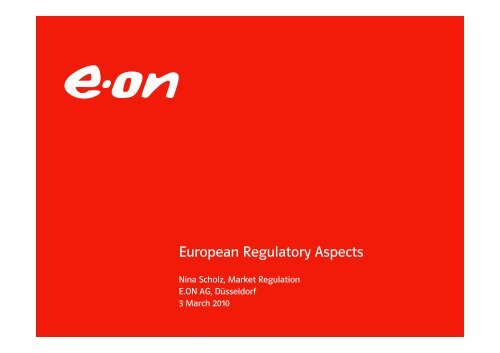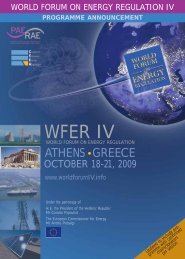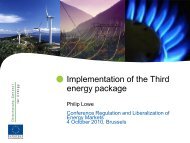E.ON presentation (European regulatory aspects)
E.ON presentation (European regulatory aspects)
E.ON presentation (European regulatory aspects)
Create successful ePaper yourself
Turn your PDF publications into a flip-book with our unique Google optimized e-Paper software.
<strong>European</strong> Regulatory Aspects<br />
Nina Scholz, Market Regulation<br />
E.<strong>ON</strong> AG, Düsseldorf<br />
3 March 2010
Contents<br />
1. Corporate Profile<br />
2. <strong>European</strong> Electricity Markets<br />
3. Regulatory systems for networks tariffs<br />
4. End consumer prices within the EU<br />
5. EU challenges
An overview of us<br />
• One of the world’s largest investor-owned power and gas companies.<br />
• Roughly 93,500 employees generated sales of just under €87 billion in 2008.<br />
• Clearly focused player with leading market positions in power and gas and<br />
approximately 30 million customers.<br />
• Operations in more than 30 countries.<br />
• Created by VEBA-VIAG merger in June 2000.<br />
Last updated: December 31, 2008
Our operations along the value chain<br />
Power<br />
Generation/<br />
Production<br />
Transmission/<br />
Wholesale<br />
Trading/<br />
Supply<br />
Distribution<br />
Retail/<br />
Sales<br />
Gas<br />
Exploration/<br />
Production<br />
Transmission/<br />
Wholesale/<br />
Gas Storage<br />
Trading/<br />
Supply<br />
Distribution<br />
Retail/<br />
Sales
Our structure: superbly positioned, in all our markets<br />
Central Europe MU<br />
E.<strong>ON</strong> Energie AG<br />
Munich<br />
Pan-<strong>European</strong> Gas MU<br />
E.<strong>ON</strong> Ruhrgas AG<br />
Essen<br />
Italy MU<br />
E.<strong>ON</strong> Italia<br />
Milan<br />
Spain MU<br />
E.<strong>ON</strong> España<br />
Madrid<br />
Corporate Center<br />
E.<strong>ON</strong> AG<br />
Düsseldorf<br />
U.K. MU<br />
E.<strong>ON</strong> UK plc<br />
Coventry<br />
Nordic MU<br />
E.<strong>ON</strong> Nordic AB<br />
Malmö<br />
Russia MU<br />
E.<strong>ON</strong> Russia Power<br />
Moscow<br />
U.S. Midwest MU<br />
E.<strong>ON</strong> U.S. LLC<br />
Louisville<br />
Climate & Renewables MU<br />
E.<strong>ON</strong> Climate & Renewables GmbH,<br />
Düsseldorf<br />
Energy Trading MU<br />
E.<strong>ON</strong> Energy Trading AG<br />
Düsseldorf<br />
MU = market unit
Contents<br />
1. Corporate Profile<br />
2. <strong>European</strong> Electricity Markets<br />
3. Regulatory systems for networks tariffs<br />
4. End consumer prices within the EU<br />
5. EU challenges
Highly meshed grids across Europe …<br />
… but further interconnection capacities strongly demanded
Increasing physical exchanges …<br />
… show an evolution from<br />
previous national markets …<br />
…show market evolution<br />
between previous<br />
national markets…<br />
→ doubling of exchanges<br />
every 10 years<br />
… towards an Internal<br />
Electricity Market (IEM) …
…but led to congestion almost “everywhere“ in Europe<br />
DK<br />
UK<br />
NL<br />
B<br />
D<br />
PL<br />
E<br />
F<br />
CH<br />
I<br />
CZ<br />
A<br />
SL<br />
SK<br />
HU<br />
90,00<br />
80,00<br />
70,00<br />
UK<br />
Entwicklung der Großhandelspreise (Frontjahr Base)<br />
Frankreich<br />
Deutschland<br />
Belgien<br />
Skandinavien<br />
Congested border<br />
EUR/MWh<br />
60,00<br />
50,00<br />
Niederlande<br />
40,00<br />
30,00<br />
20,00<br />
Quelle: EST-TA<br />
10.1.03 10.5.03 10.9.03 10.1.04 10.5.04 10.9.04 10.1.05 10.5.05 10.9.05 10.1.06 10.5.06 10.9.06 10.1.07 10.5.07
Extra-high voltage tariffs (electricity)<br />
since 2004<br />
T = 0<br />
T<br />
G<br />
Transmission<br />
Generation<br />
~<br />
~<br />
L<br />
Load<br />
~
Inter-TSO Compensation<br />
Basic idea:<br />
• Exporting and importing countries pay into a fund<br />
• Transiting countries receive compensations for hosting transits according<br />
to costs occurred<br />
Infrastructure<br />
Losses<br />
⇒ No incentives for new infrastructure, just compensation of costs
Coordination and transparency on investments<br />
Nationally (Germany)<br />
→ Efficiency proof against joint grid models with neighbouring TSOs<br />
→ Efficiency proof against planning assumption (e.g. load growth, transists)<br />
→ Every 2 years to report extensively on projects planned and reasons for<br />
and quarterly on progress regarding single projects<br />
Regionally<br />
→ Coordination of grid maintenance and expansion projects<br />
→ Regional investment plans<br />
Europe wide<br />
→ Publication of 10 year investment plan
Investment funding from congestion rents<br />
• TSOs have to coordinate congestion<br />
management to be operate either<br />
by explicit or implicit auctions<br />
→ Rents can flow into a common funds<br />
→ Jointly useful projects can be paid from<br />
• Regulation 1228/2003 allows to use<br />
those congestion rents<br />
→ for expanding interconnection capacities<br />
→ for the operation of interconnection<br />
→ for incorporate into national tariffs<br />
France, UK<br />
& Ireland<br />
Central<br />
West<br />
South West<br />
Northern Europe<br />
Central East<br />
Central<br />
South<br />
Baltic<br />
States<br />
Energy Community<br />
(prev. Athens Forum)
Forward Price Development - Front Year Base<br />
120.00<br />
110.00<br />
100.00<br />
90.00<br />
80.00<br />
EUR/MWh<br />
70.00<br />
60.00<br />
50.00<br />
40.00<br />
30.00<br />
20.00<br />
1.9.04 1.12.04 1.3.05 1.6.05 1.9.05 1.12.05 1.3.06 1.6.06 1.9.06 1.12.06 1.3.07 1.6.07 1.9.07 1.12.07 1.3.08 1.6.08 1.9.08 1.12.08 1.3.09 1.6.09<br />
Source: EET MAP<br />
France (OTC) ENDEX Netherlands (OTC) Nordpool UK (OTC) EEX
Contents<br />
1. Corporate Profile<br />
2. <strong>European</strong> Electricity Markets<br />
3. Regulatory systems for networks tariffs<br />
4. End consumer prices within the EU<br />
5. EU challenges
EU Member States have different <strong>regulatory</strong> approaches<br />
for distribution networks …<br />
Revenue Cap<br />
Possibility<br />
of derogations<br />
Price Cap<br />
Efficiency Factor<br />
Quality element<br />
Benchmark System<br />
Regulated<br />
Asset Base
The revenue cap formula in Germany<br />
noncontrollable<br />
cost<br />
efficient<br />
cost<br />
distribution<br />
factor<br />
inefficient<br />
cost<br />
inflation<br />
factor<br />
general<br />
X<br />
Expansion<br />
factor<br />
Quality<br />
• Tax<br />
• Charges payable<br />
to upstream<br />
network<br />
operators<br />
• …<br />
• for removal of<br />
inefficient cost<br />
• plays the role of<br />
the individual X<br />
• derived from benchmarking<br />
• for DSOs only<br />
• takes into account<br />
significant changes in<br />
area, customers, or<br />
maximum load
Key elements of the incentive regulation in Germany<br />
• Start of incentive regulation: 1 January 2009<br />
• Regulatory period:<br />
• Start level of revenues:<br />
• Revenue adjustment:<br />
• General X:<br />
• Individual X:<br />
• Quality regulation:<br />
• Investment budgets:<br />
• Simplified system:<br />
5 years<br />
last approval before incentive regulation<br />
(i.e. cost base 2006)<br />
efficiency targets on controllable cost<br />
(including capital cost)<br />
1.25 % (1 st period), 1.50 % (2 nd period)<br />
derived from benchmarking<br />
(reduction of indiv. inefficiency in 2 periods)<br />
yes, but introduction postponed<br />
for grid extensions by TSOs<br />
for very small network operators
Example UK: Building block approach<br />
Allowed cost of<br />
capital<br />
Company specific<br />
volumes at<br />
benchmarked unit<br />
cost<br />
Efficiency<br />
targets based<br />
on OPEX<br />
benchmarking<br />
Bonus/penalty<br />
from incentive<br />
performance<br />
Regulated network<br />
charge<br />
= Fixed return on + CAPEX + OPEX allowance +<br />
capital<br />
allowance<br />
Incentives<br />
Incentive<br />
Gear up<br />
Invest CAPEX to<br />
deliver agreed<br />
network outputs<br />
at efficient cost.<br />
Reduce OPEX<br />
Outperform<br />
Implications<br />
• Agreed network output measures need to be delivered or the potential exists for<br />
allowances to be clawed back<br />
• The same incentive rate is applied to under/over spends for opex and capex<br />
(with the exception of business support costs / non operational capex where a<br />
100% incentive rate applies)<br />
• Application of approach probably limited to countries with low number of<br />
operators – otherwise high <strong>regulatory</strong> effort due to individual CAPEX agreements<br />
19
Example UK: Incentives & Funds DPCR 5<br />
Promote and reward<br />
•Care of the Environment,<br />
•Customer Service,<br />
•Cost Efficiency,<br />
•Innovation<br />
Losses<br />
Business Carbon Footprint<br />
NEW<br />
NEW<br />
Low Carbon Network Fund<br />
NEW<br />
Distributed Generation<br />
Transmission Exit Charges<br />
IQI and Equalised Cost Incentives<br />
Network Performance<br />
A<strong>ON</strong>B<br />
Customer Satisfaction<br />
Guaranteed Standards<br />
Worst Served Customer<br />
Unregulated Margins in Connections<br />
New<br />
Formula<br />
Bigger<br />
Innovation Funding<br />
Bigger<br />
NEW<br />
More<br />
20<br />
NEW
Contents<br />
1. Corporate Profile<br />
2. <strong>European</strong> Electricity Markets<br />
3. Regulatory systems for networks tariffs<br />
4. End consumer prices within the EU<br />
5. EU challenges
3rd package does not prescribe regulated tariffs<br />
•Member States are given the possibility by the directive to impose<br />
obligations on undertakings which may relate to price of supplies (Art. 3 (2)<br />
Dir 2007/0195 and 2007/0196).<br />
•The provision within the electricity directive demands that prices for<br />
household customers and small enterprises shall be universal, transparent<br />
and non-discriminatory (Art. 3 Dir 2007/0195).<br />
•Against energy poverty and to protect vulnerable customers a national<br />
action plan, or other appropriate frameworks, such as social policy actions<br />
should be developed by Member States (Art. 3 Dir 2007/0195 and 2007/0196)<br />
•But <strong>European</strong> regulator group ‘ERGEG’ stated in its position paper in 2007<br />
that protecting vulnerable customers should not be mistaken with<br />
regulated tariffs for all or certain categories of customers.
Contents<br />
1. Corporate Profile<br />
2. <strong>European</strong> Electricity Markets<br />
3. Regulatory systems for networks tariffs<br />
4. End consumer prices within the EU<br />
5. EU challenges
There is not one market, but a multitude of them<br />
With a rise of <strong>regulatory</strong> diversity also a rise of complexity comes along the<br />
potential increase of <strong>regulatory</strong> risks.<br />
Particularly for investors and multinational energy companies<br />
UK<br />
DE<br />
…<br />
ES<br />
FR<br />
A<br />
Harmonization<br />
A single<br />
<strong>European</strong><br />
Regulation<br />
Framework<br />
P Therefore more harmonization is needed but …
Regional markets to facilitate market integration<br />
National<br />
energy market<br />
<strong>European</strong> Energy Regulators (ERGEG)<br />
Regional<br />
energy market<br />
(REM)<br />
Single<br />
energy market<br />
(SEM)<br />
• Different initial conditions<br />
in Member States<br />
• Facilitate the development<br />
of regional markets<br />
• Remove barriers to trade<br />
and competition<br />
• Working in cooperation<br />
with stakeholders<br />
• Price convergence<br />
• Full transparency<br />
• Central <strong>regulatory</strong> oversight<br />
• Unique market design and<br />
harmonized rules related to<br />
• Reliable and efficient grids<br />
7 REMs as part of Electricity Regional Initiatives (ERI)<br />
3 REMs as part of Gas Regional Initiatives (GRI)<br />
Internet: http://www.energy-regulators.eu/portal/page/portal/EER_HOME/EER_INITIATIVES
Europe faces significant challenges to find the right<br />
balance<br />
Climate targets<br />
Consumer Rights/<br />
Competition<br />
Security of Supply/<br />
Integration




